Royal Children’s Hospital’s Good Friday Appeal 2023: One step at a time for plucky little McKenzie
Little Leo Cussen has a combination of three conditions no one else in the world has, but that hasn't stopped him growing into a "resilient, cheeky, part-time musician" who loves his toy instruments, animals, food, and swimming.
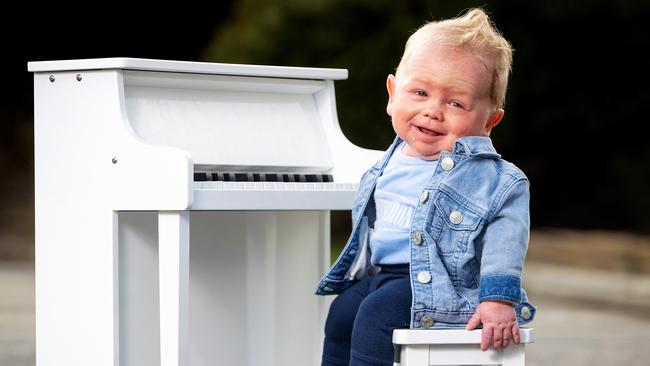
Victoria
Don't miss out on the headlines from Victoria. Followed categories will be added to My News.
Leo Cussen truly dances to his own tune.
He has a combination of three conditions that nobody else in the world has.
But thanks to the Royal Children’s Hospital incredible teamwork, he has grown into a “resilient, cheeky, part-time musician” who loves his toy instruments, animals, food and swimming.
Mum Rhiannon Cussen says 16-month-old Leo would not be here without the hospital, whose staff came up with innovative solutions when the treatment for one condition risked aggravating another.
Her “brave little boy” has Netherton syndrome, a rare genetic disorder that affects his skin, hair and growth; and was born with both his feet turned inward.
He also receives fluids via a feeding tube, which he carries around in a little backpack, as he struggles to swallow fluids without them entering his airway.
Rhiannon said his sunburnt-like skin – which leaves him prone to infections – could not tolerate the weekly casts typically used to correct his feet and ensure he could one day walk on them.
“The amazing staff would often use their lunch breaks to come and change Leo’s plasters each day on the ward,” she said.
“After approximately eight months of treatment, 126 casts, a surgery and a whole lot of effort from the team, Leo graduated to his boot and bar.”
This progress is just one example of the massive team backing little Leo, who spent more than 200 days at the hospital in his first year of life and still visits from Bendigo several times a week.
“He just bounces back from everything,” she said. “He is starting to talk, put weight on his legs and is very interested in the world around him.”
He has come a long way since he was in the neonatal intensive care unit – where he fought off a life-threatening sepsis complication – and Rhiannon listed 20 different departments that have helped with his care, from genetics and paediatric surgery to physiotherapy and dietetics.
“They’re pretty amazing and phenomenal and they all just put the kids first,” she said. “The efforts of the RCH have been outstanding for Leo and also for the other few children around the world with Netherton syndrome, who can now benefit from the research and trials conducted here.
“We are so very blessed to have the RCH and the Good Friday Appeal, it saves the lives of little superheroes like Leo every day.
“Leo’s smile says it all.”
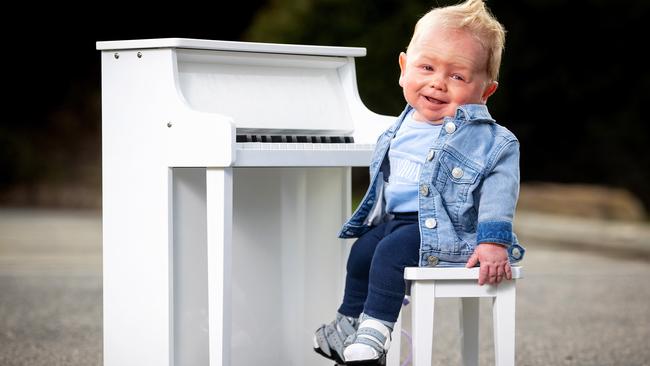
One step at a time for plucky little McKenzie
McKenzie loves his bicycle, “diggers” and cars, racing down the hospital corridors as Royal Children’s Hospital prosthetist Nessen Chokupermal begins his check-up with a trip to the toy cupboard.
It’s a sight that means everything to his mother Cassie Stanforth, who alongside husband Luke, had to make a life-changing decision on their now two-year-old son’s behalf.
She was 20 weeks’ pregnant with McKenzie when they discovered he had fibula hemimelia and was missing his fib-ula and a toe, while his tibia (shin bone) was half the size of his other leg. She said doctors gave them two treatment options – an amputation below the knee or leg-lengthening.
“The lengthening is a long, painful process for the entirety of his childhood until he’s 16 and he stops growing, which could have ended up in an amputation anyway,” Ms Stanforth said. “We thought ‘what’s the point in putting him through all that pain for it to end the same way when he’s a teenager’.”
She said the only time she questioned their choice was when a then one-year-old McKenzie came out of surgery.
“It was very emotional,” Ms Stanforth said. “I just sat there … seeing him in pain, screaming it was just, ‘did I do the right thing?’.”
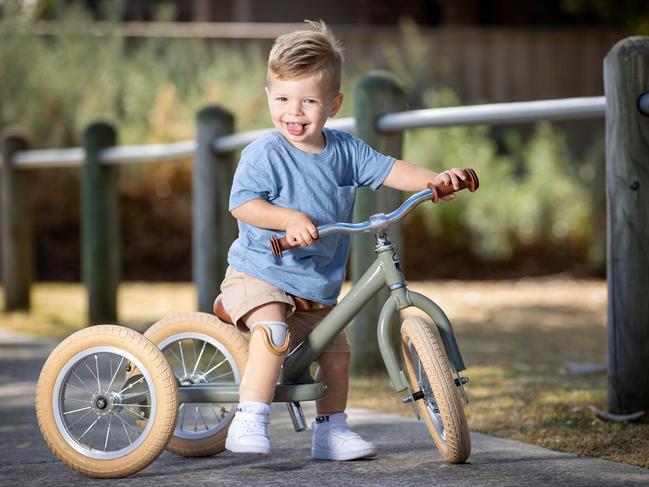
But she said as soon as he got his cast off and began to move around, she knew this “was how it was meant to be”.
“I’ve never wanted to say ‘no’ to him; if he wants to try and do something, go for your life,” Ms Stanforth said.
A chance encounter at the supermarket reinforced that they had made the right decision when they met a woman who had been born with the same condition as McKenzie.
“He sat there touching her prosthetic and then he showed her his and it was just a really beautiful moment,” Ms Stanforth said. “She said she didn’t get her amputation until she was in her mid-20s and she wished her parents had got it done when she was baby.”
McKenzie is confident with and without his prosthetic, jiggling his stump to show it off as he races cars along the bed during his appointment. Ms Stanforth said her son was protective of his leg at daycare – sleeping with it next to him during nap time – and played jokes with his stump, deliberately sticking it into a hole in the cot. “He’ll look at them and go ‘help, I’m stuck’ every single nap time,” she said.
It’s a confidence she doesn’t want him to ever lose.
“The main thing I hope for his future is for him to feel normal,” Ms Stanforth said. “The last thing I want is for him to come home feeling different.”
And thanks to the backing of the “amazing” Royal Children’s Hospital, who will be there every step of the way, there truly is nothing little McKenzie can’t achieve.
Lucas leading our big fight
A “promising” gene therapy has offered hope to children with an incurable degenerative disease, after a chatty toddler with a love of trains became Victoria’s first trial patient.
The “exciting” treatment is not a cure, but Royal Children’s Hospital paediatric neurologist and trial principal investigator Dr Ian Woodcock hopes it could be the first effective treatment for Duchenne muscular dystrophy (DMD).
The life-shortening and severe muscle-wasting genetic condition can first appear in toddlers and progresses as children – mostly boys – age.
Dr Woodcock said until now, long-term steroid use – which can hurt children’s immune systems, growth and more – had been the best treatment option.
“They help keep boys walking on their feet for probably an extra two years,” he said.
“It’s the best we have … but it’s a long way off an effective treatment or getting close towards a cure.”
Dr Woodcock said the hospital’s involvement in the trial was “very exciting”, emphasising it was a team effort and the culmination of decades of research.
“It is at an early stage,” he said.
“(But) the overriding feeling in the community is that gene therapy is the big hope.
“There’s a real hope that this gene therapy could either reverse any injuries that have already happened, which would be fantastic, or slow and prevent significant progression.”
Three-year-old Lucas Cooper received the gene therapy last week at the RCH as part of a five-year trial, becoming the first patient in Victoria – and just the fourth in Australia – to receive the one-time treatment.
Mum Sarah Cooper said they were overjoyed when they found out Lucas had been selected and felt optimistic after his treatment on Tuesday.
“This is potentially life-changing for him,” she said.
“If it’s successful, it means it’s life-changing for other families in the future. It’s been a bit of a bumpy road to get here, so we’re feeling very relieved that we finally made it.”
Dr Woodcock said patients with DMD had a “faulty” gene, which can interfere with their ability to produce a critical protein.
“The way gene therapy works is that we package up a gene or part of a gene into a virus, which we then inject into the body,” he said. This particular treatment uses a harmless virus to deliver a gene which has been found naturally in some men who have a different type of muscular dystrophy, one that has a slower onset.
“It doesn’t change his (Lucas’s) genetic information,” Dr Woodcock said.
“It just sits there as an extra piece of genetic information that’s going to get to work producing this missing protein.”
He said it would be fantastic if, one day, he could offer parents effective treatments in the moments after he diagnoses their son with the condition.
“To be able to break the bad news and then follow up with ‘But we have treatment’ … that would just be incredible,” he said.
“Hopefully the trial proves positive and then we can go through all the regulatory procedures and start to be able to offer this medicine commercially to all our boys.
He added: “We wouldn’t be able to run the clinical trials without the support of charity and without the support of the Good Friday Appeal.
“Running a clinical trial is very challenging. Without the investment from charitable counterparts … we would really struggle.”
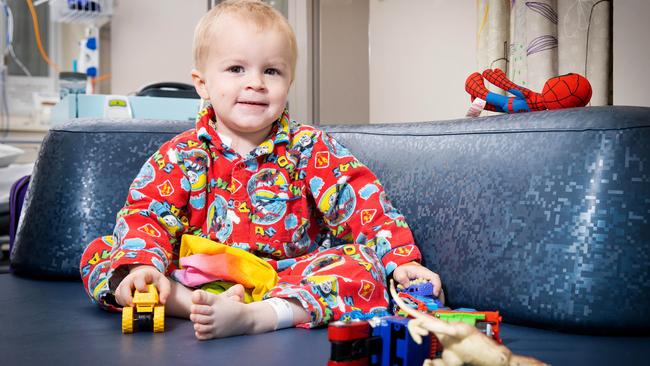
Where footballers go to find real heroes
It doesn’t matter how big or small you are – bravery comes in all sizes.
That was shown when inspirational Carlton footballer Sam Docherty met little legend Mason Cheong at the Royal Children’s Hospital on Monday, putting a smile on the two-year-old’s face.
Docherty, who returned to football last year after a second cancer diagnosis, was at the RCH to visit sick children and help launch the Good Friday Appeal.
He met a delighted Mason, from Kyabram, who has had kidney complications and was born with Lowe syndrome, cataracts and low muscle tone.
Mason’s father, Aden, said the support that AFL players continually showed the RCH did not go unnoticed.
“They’re all so good with the kids, it’s just awesome how they lighten up the children and bring smiles to so many faces,” he said.
“All of the players were coming up to Mason, asking how he’s going, and you could tell that they actually cared and they were happy to be there.”
Mr Cheong said his son’s fight was far from over, but he was making progress.
“He’s had a rough start to life,” he said.
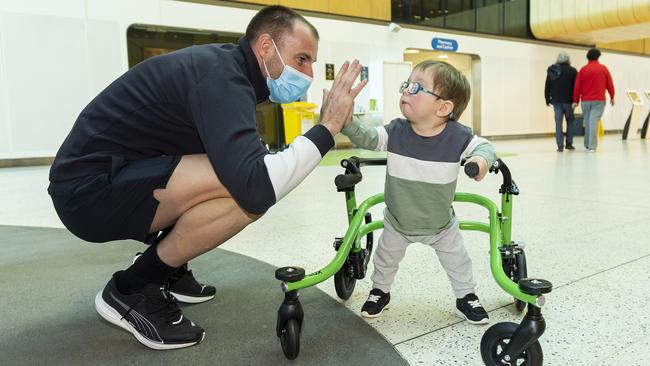
Saving Celeste
Celeste Wilson sat in the emergency department, waiting to find out whether the “lump in my tummy” was cancer, and looked up at her terrified parents.
“You guys are worried, but I’m going to be fine,” she said. “Don’t worry.”
Ben Wilson’s pride – and amazement – at his daughter’s positivity is clear as he tells the story.
“Five weeks ago, we were just a normal sort of family going about our lives in a pretty standard way,” he says. “All of a sudden everything was just turned upside down.”
It was a simple but persistent cough that prompted Celeste’s mother Rachael Wilson to take her to the doctor.
But in checking for signs of glandular fever the GP noticed a tightness in Celeste’s stomach and booked an ultrasound.
A day later they got a call telling them to "drop everything" and return to the clinic.
“(They) found a pretty significant mass on her right kidney,” Ben says.
“Next minute, we were on our way into the Royal Children’s emergency department.
“The whole world just pretty much stopped at approximately 10.30 on that Thursday.”
A scan on the Friday confirmed their fears – Celeste had a type of kidney cancer, Wilms tumour – and she started a four-week course of chemotherapy the next day to prepare for surgery.
“Everything moved really, really quickly,” Ben says.
But, he adds, Celeste’s optimism helped to keep them going.
He and Rachael were worried for her fifth birthday – which fell shortly after diagnosis – but she woke them up bright and early ready to celebrate, and marked the occasion with a fairy party.
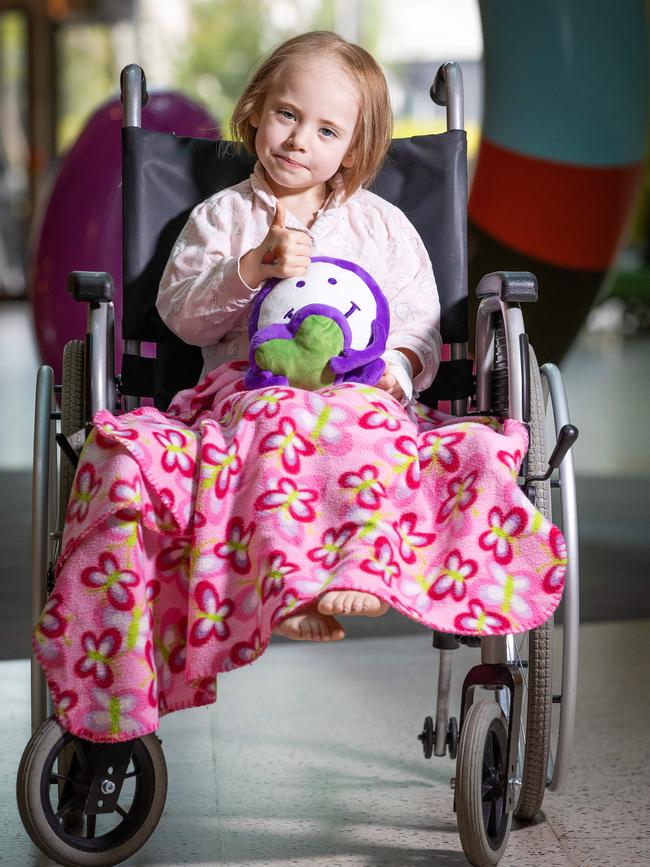
Celeste knew she had a lump that was “not supposed to be there”, but Ben says she took it in her stride and had been happy to talk about and document her experience.
“I wrote a newspaper article about the lump in my tummy,” Celeste told the Herald Sun when we first met her.
Moments later her attention was back to the toys in her bag – sparkly pink like most of her belongings – and she shrieked with laughter as she pulled out colourful “worms” one by one.
Ben has promised to shave his head when post-surgery chemotherapy takes his daughter’s hair and asks Celeste about their plans for “when our heads are bald”.
“We’re going to paint our heads pink,” she says, eyes wide with glee.
Even last Monday, when they arrived for surgery, Celeste had remained upbeat, climbing over the waiting room couches, playing the ukulele with Captain Starlight and listing the three foods she could not wait to eat afterwards.
“Cookies, chocolate and chocolate cookies,” she said.
Rachael tapped her bag with a knowing smile, and said she was well stocked.
It was not until they were called into pre-op that the reality of the situation hit little Celeste, whose main complaint until then had just been her hunger.
She cried in her mother’s arms, her chest shaking with each sob as Rachael stroked her hair and silently blinked away her own tears.
“Mummy, I want to go home,” she cried.
Rachael and Ben hugged their daughter tighter.
But at The Royal Children’s Hospital, help is always nearby and a child life therapist appeared at Celeste’s bedside, a warm smile beneath her mask.
She coaxed a giggle from Celeste, who laughed at a toy egg, which popped out a green baby dinosaur when squeezed between her fingers.
When the time came, Ben leant down to whisper goodbye and promised his daughter she would be fine.
“I love you, I’ll see you soon,” he said.
Rachael walked beside Celeste’s bed, holding her hand as she was wheeled away for anaesthetic.
Ben stayed back in the now empty hospital bay, clutching his daughter’s bag of toys, and their agonising wait began.
IN the theatre, Paediatric Surgery department director Michael Nightingale and his team were ready.
Dr Nightingale said the chemotherapy Celeste underwent would make the tumour easier to remove.
“Her tumour is half the size of what it was,” he said.
“But the real advantage to a surgeon is that it makes the tumour a little bit more robust and easier to handle.”
Over the space of a few hours, Dr Nightingale and his team would carefully remove one of Celeste’s kidneys, and with it the tumour that had caused so much grief.
The nurses observed the surgeons with practised eyes, and seemed to know which tool to sel ect from their trolley of carefully counted and sterilised instruments before Dr Nightingale even asked.
Eventually Dr Nightingale stepped away from Celeste, removed his gloves and reached for the phone. The surgery had gone well.
“The poor parents are sitting out there with the worst three hours of their entire life,” he said.
“I’m pleased it went well, it’s always fun ringing the parents.”
He said while he was the one who got to make that call, it was a “team effort” to save Celeste.
“The good news is that if she takes good care of herself and of her kidney and eats a good diet … there’s no reason that she can’t live a completely normal life,” he said.
“There are some people who are born with only one kidney.”
A completely normal life sounds amazing to Ben and Rachael, who cannot wait for Celeste to return home to one-year-old sister Emily, who she has missed terribly this week while recovering in hospital.
Ben says it was “a massive relief” to get Dr Nightingale’s call, and later be reunited with their daughter.
“It was hard to see her recovering … but we’d been looking forward to seeing her since the moment she went into theatre,” he says.
“It was beautiful to be able to see our girl again.”
After cuddles – and a chocolate Paddle Pop – Celeste turned to them and asked, “Is the lump gone?” Yes, they told her. Yes it is.
Three days after surgery, Celeste and her family are in good spirits.
Recovery had been more difficult than expected after she caught a virus that triggered a nasty fever.
But on Thursday afternoon, Celeste feels well enough to briefly leave her room, and even ask her dad to “race” her wheelchair down the hospital’s main corridor. Five weeks to the day since she had told her parents everything would be OK, Dr Nightingale had called with an update. Celeste had been right. Her tumour was stage one and had not spread.
Ben says no words can capture their gratitude to the hospital and its staff.
“It takes a very special sort of person to do day in and day out what they do,” he says. “They have made what has been a really difficult journey for all of us a hell of a lot easier than it could have been.”
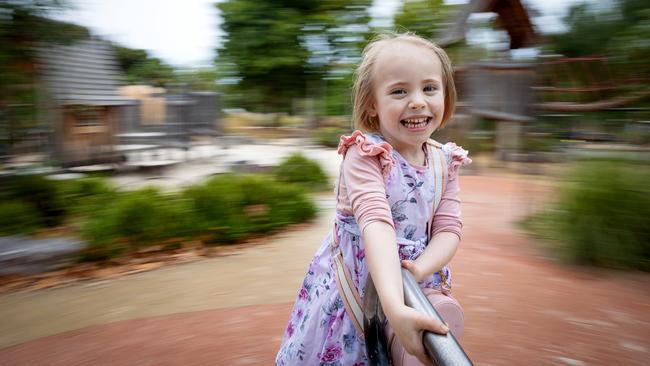
Little towns, big hearts
Boorhaman may be one of Victoria’s smallest towns, but its residents have some of the biggest hearts.
With a population of just 126, the people of tiny rural Boorhaman in the state’s northeast have banded together to raise tens of thousands of dollars for this year’s Good Friday Appeal.
After a year of weekly raffles, the Boorhaman community has raised more than $36,400 – about $289 per person – but their fundraising efforts show no signs of slowing down, with a massive family day planned for Good Friday.
Fundraising committee member Katie Batchelor said the town’s annual Good Friday charity auction – for which businesses donate everything from gift vouchers to hardware equipment to be auctioned off – usually draws some of the largest donations.
“We have a whole day that’s like a big family day, so we have stuff for the kids like a jumping castle and face painting,” Mrs Batchelor said.
“We’ve got raffles, we do food and then we have a big auction, which is all goods and services we get donated … We’ve got motorbike rides this year as well. We’ve got a very busy day.
“It just means money to help the kids.”
The Good Friday Appeal holds a special place in Mrs Batchelor’s heart after her daughter, Charlee, was diagnosed with rheumatoid arthritis and treated at the Royal Children’s Hospital when she was just seven.
Boorhaman is not the only small regional town donating big-time to this year’s Appeal – tiny Berriwillock, with a population of just 184, in the state’s northwest, has raised $43,000, while Telangatuk East, population 135, near Horsham, will be donating more than $14,000.
The Devenish, Dookie and St James community in the Goulburn Valley has raised a whopping $100,000 between less than 600 people, and neighbouring Tungamah has put up $43,848.
Pomonal and Garvoc, in western Victoria, fundraised $47,834 and $27,422, respectively.
The 287 residents of the northeastern town of Tatong have pooled together about $17,520, while Tooleybuc, along the Murray River, will give more than $13,317 to the Good Friday Appeal.
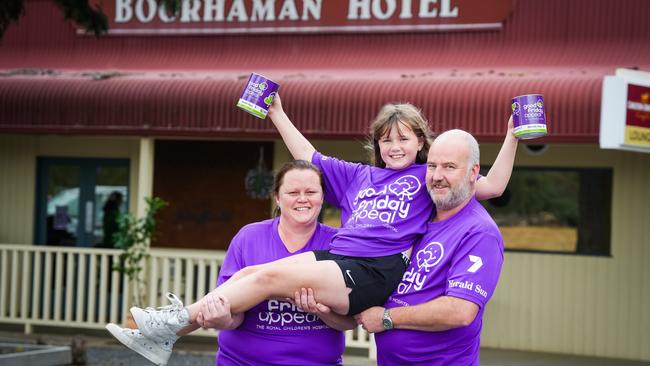
Full marks for their fabulous feat
It’s more than a marathon for these wonderful walkers.
On Thursday, almost 400 students from four Langwarrin schools sported their broadest smiles – and sturdiest shoes – as they took on a huge challenge for a great cause.
Students from Elizabeth Murdoch College, Woodlands Primary, Langwarrin Park Primary and Langwarrin Primary walked more than 50km from St Kilda to Frankston over the course of one day.
Leaving their schools at about 5.45am and starting the lengthy walk at 7am, the participants raised more than $190,000 for the Good Friday Appeal.
According to event organiser Jess Wade, the reason for the connection to the appeal was simple enough – GFA chair Penny Fowler is related to one of the participating school’s namesakes.
“We participate because of the connection with Dame Elizabeth Murdoch, who is Penny Fowler’s grandmother,” Ms Wade said.
“We were lucky enough to have Penny join us for the first 10km, which was awesome.”
The event has been running every second year since 2014, drumming up more than $655,000 in donations in that time.
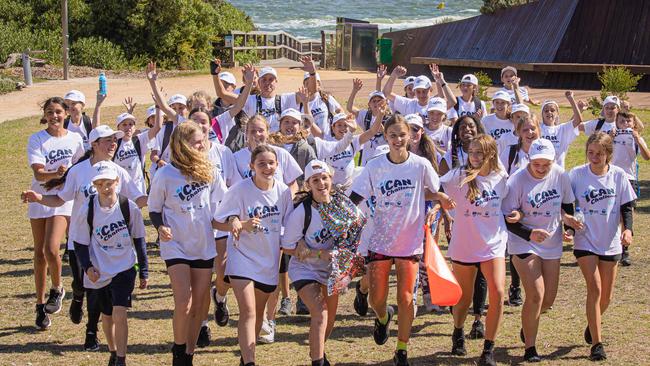
A little fighter’s triumph
As their newborn son was fighting for his life in the neonatal intensive care unit, two parents clung on to hope and named him after the fight they knew he had within him.
The only child in Australia with his condition, Cesur – which means brave in Turkish – has now grown up to be the “little fighter” his parents Gul and Alper Arik envisioned.
Cesur was born with a rare neurodevelopmental syndrome called RERE syndrome – one of less than 150 kids in the world – and has had to undergo multiple surgeries.
His mum, Gul, said it was her husband who first suggested their son’s name.
“It was a bit of a nightmare because when I gave birth to Cesur he wasn’t breathing and there were a lot of complications,” she said.
“I was ruined. My husband Alper looked at me and said ‘he’s a brave boy Gul, he’s going to fight through this’. ‘He’s got this. He’s so brave’.”
Gul said they were told there was a high possibility Cesur – now aged two – may never walk.
But her “brave little man” is now taking big steps with his walking aid.
“Four times he’s come close to death,” she said.
“We were called to the hospital… saying he’s taking his last breath, we want you there.
“And he’s pushed through and he’s done so well and he is with us today.
“So we’re quite proud.”
Gul said it was too soon to know how the syndrome will affect Cesur’s day-to-day life as he grows.
But she says she is confident he can reach his milestones. “I believe in my heart that – in time with the right support and help he is getting from the Children’s – he will get there,” she said.
“It’s just an amazing place to be.
“You feel like you’re a part of a family.
“I just want everyone to put their hands in their pocket and donate as much as they can.”
Dad Alper said they can still remember the board of donor names’ outside the wards where Cesur spent so much time.
“We were just so thankful and grateful to those people,” he said.
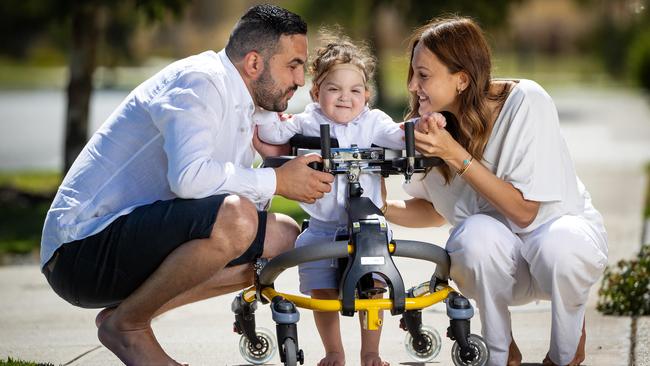
Xavier’s precious gift of life
Just like his favourite character Hairy Maclary, seven-year-old Xavier wants to go out and play with his friends.
But he has faced more obstacles than a simple garden fence to do so, and was diagnosed with an aggressive liver cancer that failed to respond to chemotherapy after he began prep last year.
Mum Heather said his health deteriorated so suddenly – they were overseas at the time – that Xavier had to be medically evacuated back to Australia.
“Literally one day you’ve got a healthy child and then … he got sick and went downhill very quickly,” she said.
It would mark the start of months in hospital, with the family of four – mum Heather Davis, dad Chris and twins Xavier and Zander – split in two as they tried to juggle life in and out of the hospital.
Xavier became increasingly unwell, until an angel saved his life and a grieving family gave a gift that nobody can ever truly repay.
With his liver cancer failing to respond to treatment, the Royal Children’s Hospital had decided the best way to fight Xavier’s liver cancer was to remove the entire organ.
Associate Professor George Alex, who is the hospital’s gastroenterology and clinical nutrition department director and looked after Xavier, said in most cases liver cancer could be treated with chemotherapy and surgical removal of the tumour.
But he said they did “one to two liver transplants a year for the purposes of a liver tumour”, when the tumour had become “quite widespread”.
Ms Davis could not hold back the tears when she shared how thankful they were to Xavier’s organ donor and their family, and said they had given her son the “opportunity of growing older”. “We’re very thankful to the family for that gift,” she said.
“I think if people can consider having that conversation (about organ donation) that’s really, really important.”
She said Xavier had been “recovering really well” and was able to return home after the transplant.
“When he’s up to going to school, he’s at school. He loves being back there.”
Ms Davis recalled Xavier’s first day of grade 1, quashing any fears the kids would not remember him after he missed out on months of classes.
“He was really excited to go back to school and see his friends,” she said. “The school made quite a big deal about it.
“They were all excited to see him and were cheering him on as he arrived for his first day.” But on the days where he does have to return to hospital, he has some friends on the ward too, such as the hospital teacher who helped Xavier make the space posters that now adorn his hospital room.
“That’s one of the highlights of the day, is knowing that his teacher is going to come in and they’re doing some schoolwork and they’re going to read,” she said. “He loves reading Hairy Maclary.”
It’s just one of the services that makes up, in the words of Ms Davis, the “world class facility” that is the Royal Children’s Hospital and she encouraged Victorians to think about donation – both to the Good Friday Appeal and as an organ donor.
“(The hospital) is second to none,” she said.
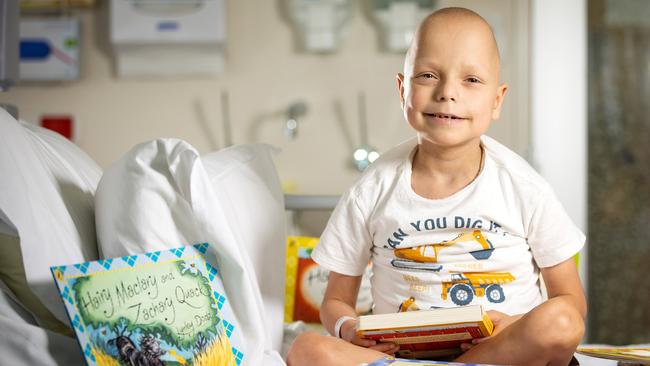
Kaiah winning the fight of her life
THE smiling toddler stands in a park at The Royal Children’s Hospital bobbing her head to the rock music she always asks her parents to play.
It’s a simple sight, but it means everything to parents Chantelle Colafella and Denis Maloney, who were told their danc-loving child had a condition so rare she was the only one in Australia, and so complex she would never walk or talk.
But here is 20-month-old Kaiah, laughing as she stands on her own two feet and signs to her parents outside the hospital that saved her life.
Even before Kaiah was born her parents knew she had a battle ahead.
Ms Colafella said after her waters broke at 17 weeks it was “touch and go” until Kaiah was delivered at 36 weeks, with doctors warning her daughter’s airways may not be strong enough to survive her birth and the “intense” surgery ahead.
Kaiah is one of about 60 known children worldwide born with a syndrome that causes breathing and feeding issues called cerebrocostomandibular syndrome.
Ms Colafella said Kaiah had a small jaw that would never grow – she faces up to 10 repeat surgeries to adjust it as she gets older. Her rib cage is missing ribs, while those she does have are “in pieces”.
“We came over here (to the RCH) when she was six days old and we were in for three months,” she said.
But thanks to an incredible team of workers – from doctors and nurses to the physiotherapist who convinced Ms Colafella it was OK to hold Kaiah – their daughter is now “flourishing” at home, with her parents trained to care for her tracheostomy.
She said they “couldn’t be prouder of this kid” who communicates via “baby sign language” known as “quick sign” as the tracheostomy required to help her breathe prevents her from speaking.
“We didn’t think we’d get here but here we are,” Ms Colafella said.
“She’s very intelligent. She’s very sassy, she’s very bossy, but it’s great because I know that she’s got fight in her.”
Kaiah loves dancing, music – her favourites include nursery rhymes, John Butler and heavy metal – and playing with her two older siblings.
“She’s just flying along,” Ms Colafella said.
“We thought she’d still be ventilated at this point.
“She’s holding my hand and walking and doing everything they said she wouldn’t do.”
When asked what the hospital and Good Friday Appeal meant to their family, she couldn’t hide the tears.
“We’re just so grateful and humbled,” she said.
“Those ventilators are so expensive … and we got sent home with two.
“If it wasn’t for the hospital, she wouldn’t be here. End of story.
“If it wasn’t for the Good Friday Appeal, we wouldn’t have her.”
There can’t be any greater reason to donate to the Good Friday Appeal than that.
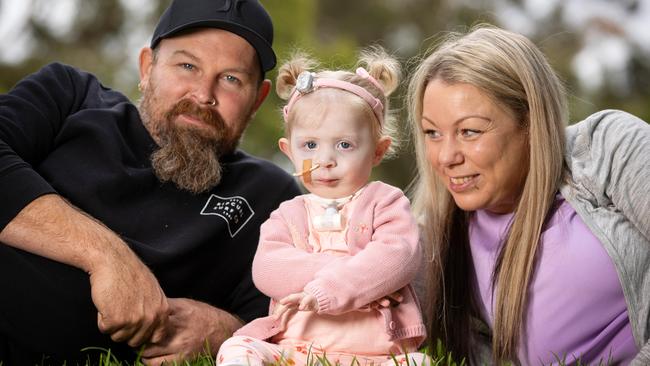
Imogen marks her medical milestone
A year to the day since she was diagnosed with leukaemia, nine-year-old Imogen was determined to celebrate.
Proud mum Shannon Mulgrew said her “amazing” daughter did not want to see this week as a sad anniversary, but instead a milestone that marks a year of courage for a child who was terrified of medical procedures.
“The pain in my heart by seeing our daughter suffer so much was extremely intense, it was so physically painful,” she said.
“I’m just in awe of how much she’s overcome and she’s matured way beyond her years.”
Imogen agreed she had a new-found confidence and said she was “excited to ring the end of treatment bell” next year.
“Before I was diagnosed, I was very shy,” she said.
She has 19 months left of her 2½-year treatment plan but, with the most intensive stage now over, she has returned to school and can receive treatment in the hospital’s day clinic, allowing her to go home to her parents and her puppy. It is all thanks to the incredible team at the Royal Children’s Hospital, but also everyday Victorians.
Anyone who has ever dropped loose change into a tin, tried their luck at the GFA raffle or laced up their shoes for Run for the Kids may have been one of the Victorians whose dollars helped the Royal Children’s Hospital join a promising international trial.
Imogen is one of 53 RCH patients undergoing a new, individualised treatment protocol after their samples were sent to the US and analysed by the renowned St Jude Children’s Research Hospital.
RCH Children’s Cancer Centre clinical nurse Grace Heffernan told the Sunday Herald Sun it was “amazing” to see Imogen back to “doing the things she loves”.
She said most of the drugs involved in the TOTAL Therapy Study XVII trial, open to children with certain types of acute lymphoblastic leukaemia or lymphoblastic lymphoma, would be familiar to past patients. But it was their specific combination and use – tailored to the genetics of a patient’s cancer – that was new and hoped to both reduce the toxicity of treatment and relapse rates. “We’re not using a one-size-fits-all approach anymore,” Ms Heffernan said.
She said initiatives like the Good Friday Appeal helped fund access to trials so the “promising results” could reach beyond the initial 53 children currently receiving treatment.
Ms Mulgrew said they felt “very blessed” to be part of the trial, which had not been available in Australia before the RCH launch.
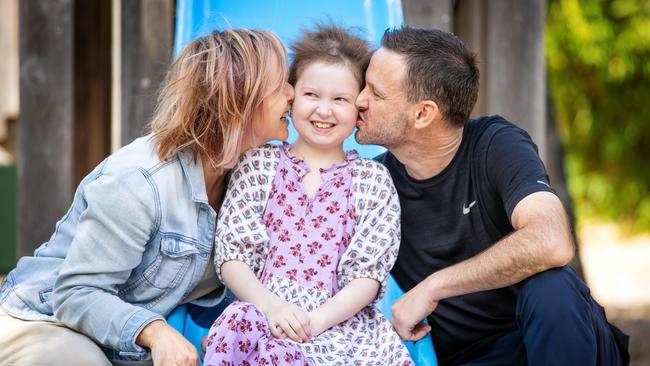
Fulfilling a promise is worth every dollar
In the days after their daughter woke from her coma, two grateful parents vowed to raise money for the hospital that had saved their daughter’s life.
Now less than a year later, a smiling toddler just weeks away from celebrating her second birthday has returned to the Royal Children’s Hospital to help fulfil her parents’ promise.
Jarryd and Jamie Newall have organised a 12-hour mini golf day in a bid to raise $35,000 — $1000 for every day that Millie Newall was hospitalised – for the Good Friday Appeal.
Millie Newall had to be placed on life support after she contracted Covid last July and had a seizure.
She was transferred to the Royal Children’s Hospital for specialised care, but her health continued to decline and she suffered a stroke.
Mum Jamie said the situation was so critical they were told to come in immediately to say goodbye.
“These are stories that you hear of from other people,” she said.
“You never think that this is something that you’re going to have to go through yourself.”
Jarryd said he promised the nurses – who cared for Millie “like their own child” – he would raise funds for the hospital when, against the odds, “the tide turned” and his daughter woke up.
“We’re obviously indebted forever for what they’ve done for us,” he said. “They literally saved her life, from the brink of death.”
You can support the Good Friday Appeal here.
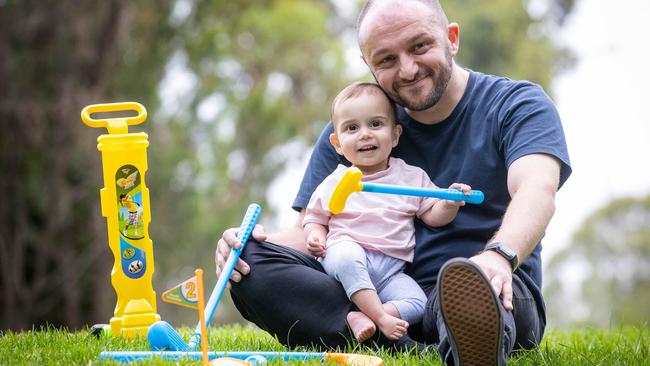
Cats stars meet their young heroes
Former Good Friday appeal ambassadors Malu Hunt and Ollie Wedding have both fought hard during their short lives.
The young champions met Geelong Cats stars Tom Stewart, Rhys Stanley and Mark Blicavs on Monday afternoon. Ollie, who had his lower leg amputated at 18 months old, isn’t letting surgery slow him down.
“He’s really, really good,” said mum Meg. “He has a blade prosthesis now, with in-built suspension, and he’s very active, jumping off everything and climbing every tree.”
Likewise Malu, who underwent surgery and rehabilitation for debilitating seizures, is living life to the fullest.
“He’s doing really well, he’s just started four-year-old kinder, making new friends and loving it,” mum Erin said.
The young pair met the Cats superstars to check out a Lara home set to go to auction to raise money for the Good Friday appeal.
Set on 512sq m opposite Villawood Properties’ Club Coridale resort, the Henley home comes fully furnished.
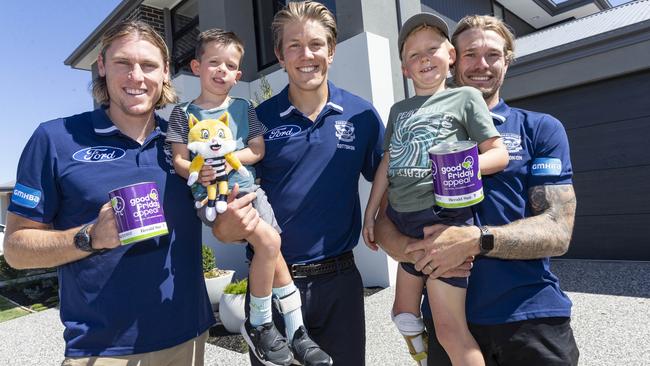
Brave baby Jax determined to beat the odds
Time and time again, baby Jax has fought to be here in his parents’ arms.
From emergency surgery within his first day of life to surviving cardiac arrest and 16 minutes of CPR at eight weeks old during a trip to the hairdressers, Renee Helmore’s and Marcus Marigliani’s “brave little soldier” has continued to beat the odds.
Renee said Jax’s “lucky stars aligned” that fateful day, from her decision to head out instead of staying home alone to the specialist ambulance that happened to be just a few minutes away.
“He had an episode where he went into respiratory arrest, followed by cardiac arrest and stopped breathing.
“We had two hairdressers and one of the ladies that was at the hairdresser getting her hair done jump in and perform, ed CPR on him,” she said. “He wouldn’t be alive without them. I will never be able to thank these people enough.
“I just remember everyone saying to me ‘you must have the most amazing hairdressers’.
“Everyone in the PICU ward upstairs said that … anyone who has had what Jax had outside of the hospital, generally the survival rate is really low.”
That day also brought Jax, now five-months old, to the team at the Royal Children’s Hospital – something Renee is forever grateful for.
It was here that a link between Jax’s condition at birth – he underwent emergency surgery to repair his oesophagus, which “didn’t go anywhere” – and the incident at the hairdressers was found.
“The respiratory team that we have here again have just left no stone unturned,” she said. “They have pretty much done every test you can think of. They found out his airway had severe Tracheomalacia, which is a condition of his (oesophagus), which not a lot of people are aware of. His airway is very, very floppy.”
But Renee said the “support and tools” from the hospital had been incredible, from the counselling services available for parents to the team’s insistence that his parents should never hesitate to bring Jax back, day or night, if they are ever concerned.
“We’ve just got this amazing network of people working with us now whether it be physiotherapists, dietitians, speech. Until you’re in this situation, you don’t know how good it (RCH) is.
“We have a phenomenal surgical team that’s been overseeing Jax as well. I think they’re probably some of the best surgeons in Australia. He is one lucky kid.”
And it’s thanks to that team that Jax – having undergone a major abdominal surgery they hope will help with his breathing difficulties – can now go home.
“He’s such a trooper,” Renee said. “I cannot speak highly enough of the hospital. We’re just so lucky.”
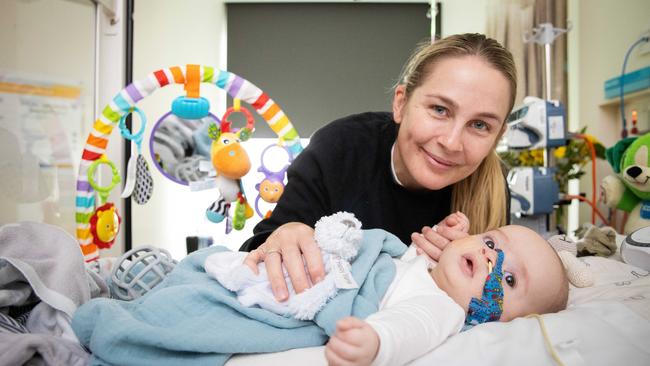
Tiny Marilou proves that dreams can come true
Marilou, like her parents, is a fighter.
Jessica Failli knew something was wrong when her then eight-month-old daughter’s left side went limp.
But it took five months of fighting and countless appointments until a regional clinic finally scanned her daughter’s brain.
It triggered a whirlwind change of pace.
The family that fought for so long to be heard found themselves rushed to the Royal Children’s Hospital that day. It was little Marilou Maxwell’s turn to be brave.
She had a brain tumour and underwent emergency 12-hour surgery – the first of several operations – followed by chemotherapy.
Marilou, 1, hasn’t had more than a week at home with her family, including Isla, 3, and dad Travis Maxwell, since that September night.
“It’s this constant rollercoaster of ups and downs,” Ms Failli said. “Every good thing comes with a bad thing and we rarely get good news.”
They were told it was a benign tumour … but in the wrong place. Then the treatment failed – twice.
Ms Failli said Marilou’s benign tumour didn’t behave like a “good” tumour and during chemotherapy – intended to treat the parts that had been too risky to surgically remove – it started to rapidly grow back.
Isla was too young to understand why her sister was ill, so they called the tumour Terry and told her Terry lived in Marilou’s head.
Before long everyone, including the treatment team, had adopted the name, inspiring the family’s new slogan: “Screw you, Terry”.
After several operations, Terry has, in part, finally got the message.
Marilou’s neurosurgeon, Patrick Lo, said the progress Marilou had made since her operation last week – when he made the difficult decision to perform “more aggressive surgery” than usual – was “absolutely fantastic”.
“I was facing a really massive dilemma here,” he said.
“If I don’t do anything, Marilou is going to die. But if I do something, and take a lot, I could really hurt her.
“In neurosurgery it’s always doom and gloom in the darkest hours.
“When you come out the other side, when there’s a light, it’s just the best feeling.
“This is what we live for.”
Marilou’s fight isn’t over.
Ms Failli said they had a “15 to 20 year battle” ahead where they will need to monitor the tumour – while investigating trial drugs – and operate again if it flares up, but she’s hopeful.
“Knowing that our neurosurgeon has taken a huge amount out this time, we know we’ve got time,” she said.
“I feel like there’s been a few times where I’ve almost crumbled, but the nurses have been there to make me stand on my own two feet and keep me going.”
For now Ms Failli holds on to the little things, from Marilou’s progress in physical therapy to the nurses who stop by to play peek-a-boo, and her unwavering belief that she will one day watch her “two little girls go down the slide together”.
“It might be a couple of years from now, but there’s going to be a day where I’ll watch her play on a playground with her sister.”
And, with the team at the Royal Children’s Hospital behind her, dreams really can come true.
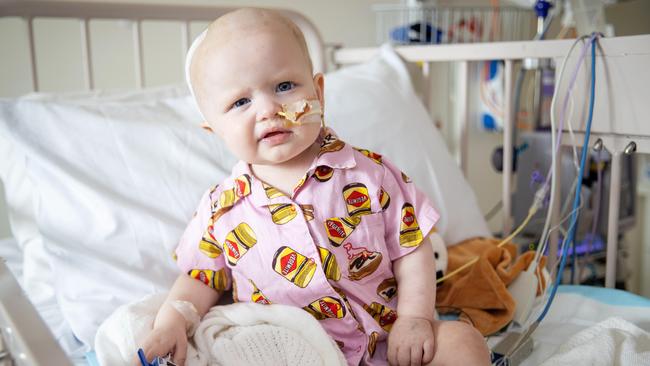
Royal Children’s Hospital’s Good Friday Appeal 2023 launched as Victorians urged to dig deep
Victorians have been urged to dig deep for our state’s smallest fighters, as the countdown begins for the 93rd Good Friday Appeal.
The beloved campaign, which has raised more than $421m for The Royal Children’s Hospital, kicked off on Thursday.
Good Friday Appeal and Herald and Weekly Times chairman Penny Fowler said the appeal would not exist without “the enduring support of our community”.
“Thank you for every dollar you donate to help our sick children,” she said.
“These children and their families face challenges that for many of us can be hard to comprehend.”
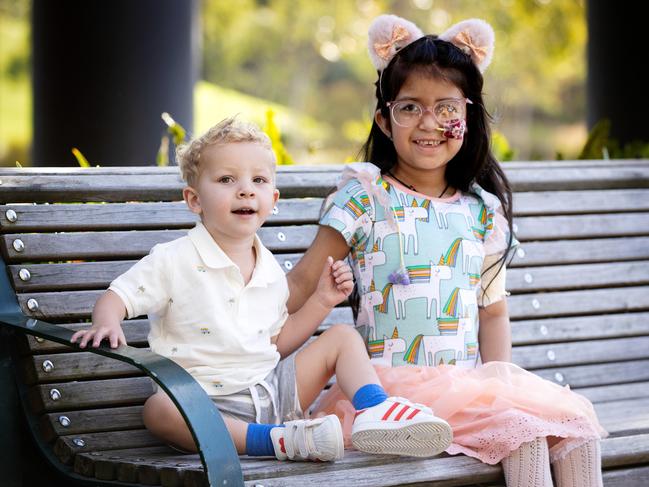
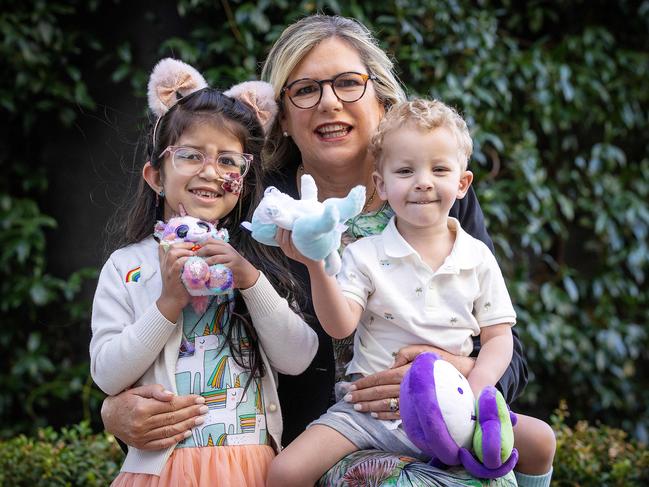
The Hospital’s chief executive Bernadette McDonald said they were “humbled” by the community’s donations, which fund vital projects such as the purchase of 19 new electrosurgical units and monitoring equipment that can help doctors save the eyesight of some of Victoria’s most vulnerable premature babies.
The families of cardiac patients Arlo, 2, and Aru, 6 – revealed in Thursday’s Herald Sun as the faces of 2023 campaign – also shared their stories, thanking the hospital that saved their children’s lives.
Aru took great delight in showing off her flashy shoes – which lit up as she walked – while Arlo was fascinated by the microphone and sang a song about trains on repeat throughout his parent’s entire heartfelt interview.
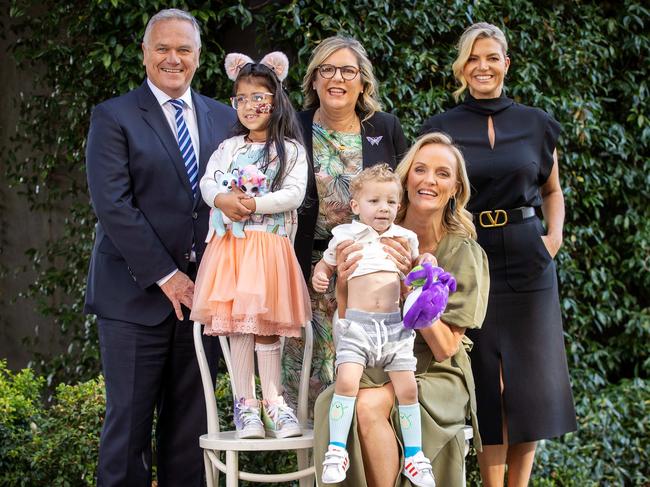
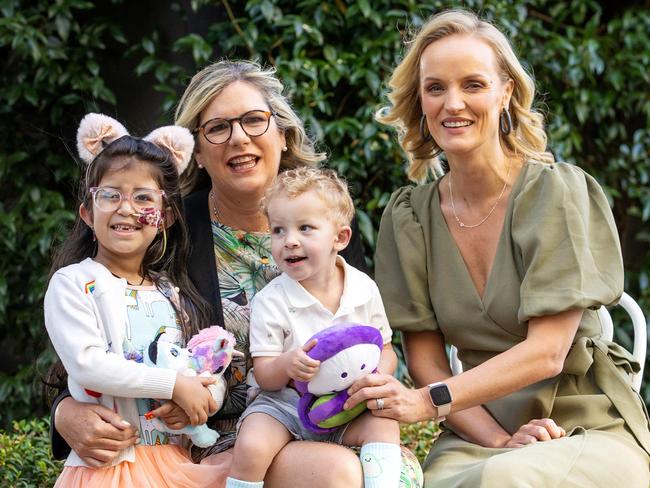
They have battled more challenges in a few years than many face in a lifetime, but they are still kids at heart.
It was a poignant reminder of why the Good Friday Appeal is held dear by so many Victorians, who give year after year so that kids like Aru and Arlo can one day have the happy and healthy childhood they deserve.
Good Friday Appeal executive director Rebecca Cowan said the “innovative and life changing projects” funded by the appeal impacted the lives of children in Australia and even overseas.
“We’ve helped to build one of the best children’s hospitals in the world and it’s here in Melbourne,” she said.
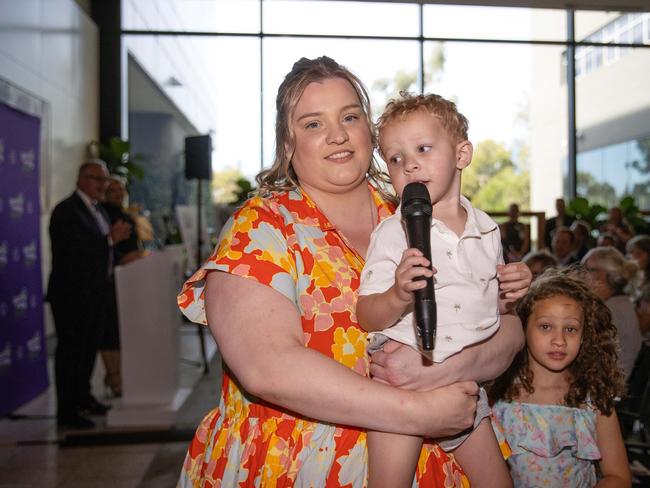
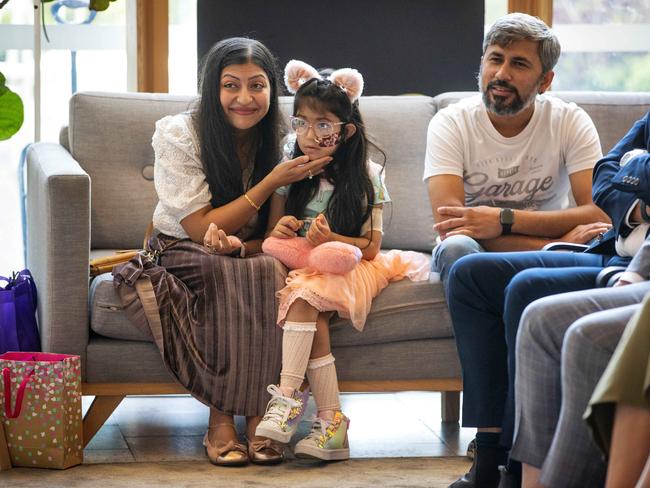
‘Little warrior’ has new chance at life
Despite everything she has been through, Aru never lost her kind heart.
The “bubbly, chatty” six-year-old loves nothing more than playing with friends and said she wants to be a nurse when she grows up because they “help sick children feel better”.
When she was born, it never occurred to her parents Smital Patel and Kiran Rathod that their happy, healthy baby would end up at the Royal Children’s Hospital, let alone the face of the hospital’s Good Friday Appeal.
They didn’t know she would call it her “second home”, or become best friends with her favourite doctors and nurses, who, on the bad days, are the only ones she will let treat her.
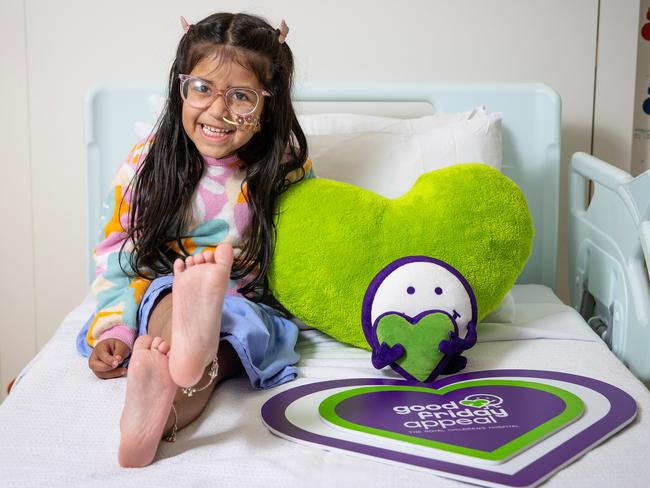
Now, Smital said they are “eternally grateful” to everyone who donates to the appeal and, without the hospital, their “little warrior” wouldn’t be here.
When Aru was six months old a chance comment from a visiting friend – an overseas doctor who thought Aru’s breathing was unusually fast – saved her life.
Her parents took her to a GP, who sent them straight to the RCH.
Their daughter was in end stage heart failure.
Smital said everything around her “froze”.
“They said if you hadn’t brought her here yesterday, she would be in cardiac arrest,” she said.
Aru had viral myocarditis – a virus was attacking her heart – and needed a heart transplant but she couldn’t wait.
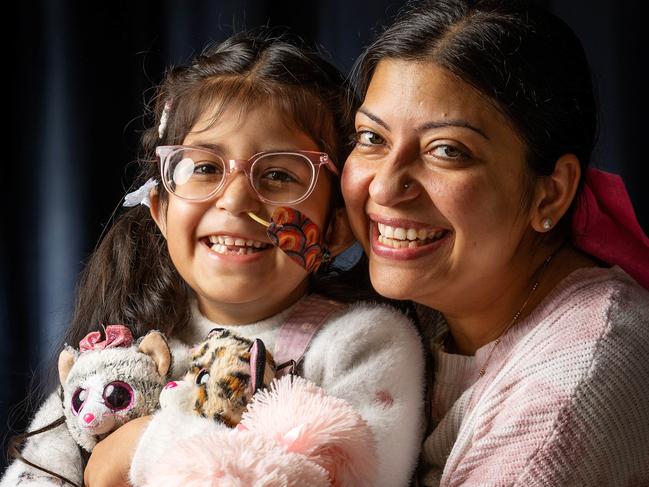
For months, her home was the hospital’s Koala Ward, where a machine acting as an artificial heart kept young Aru alive.
“The children would come out in the hallways with their big Berlin heart machines and they would sit on the mat with their toys and play together,” Smital said.
Just before Aru’s first birthday, the family received some long-awaited news.
Smital said it was bittersweet to know “somebody had lost their life to give us this precious gift”.
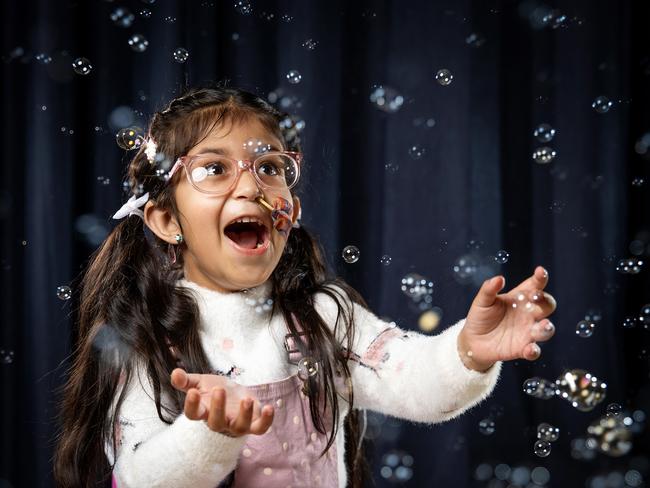
“We are forever grateful to that family,” she said.
“At the worst time of their lives they decided to do organ donation and now she’s got a second chance of life.”
Smital and Kiran kissed their daughter goodbye before she underwent a 12-hour surgery.
“The six months (in hospital) didn’t feel as long as those hours,” Smital said.
Aru’s recovery was always expected to be difficult. She needed therapy to learn how to walk, talk and eat but in 2019, her family began to fear something else was wrong.
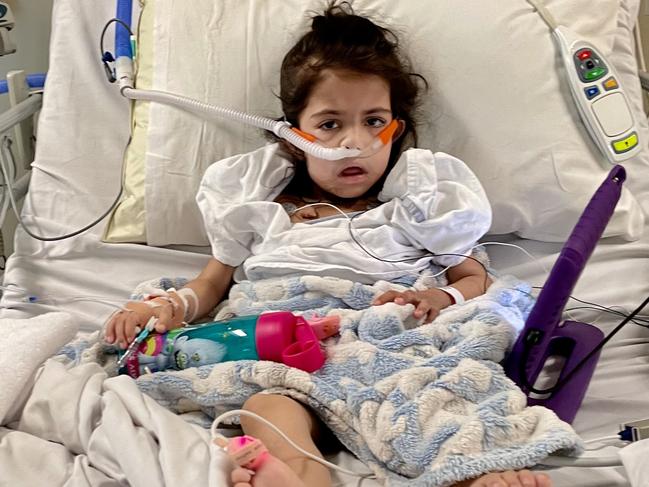
Aru had developed a rare transplant complication and precancerous condition called PTLD.
She underwent treatment on the cancer ward to fight it off twice, but on Christmas Eve last year Aru – now thriving at school – was diagnosed for a third time.
But her parents are determined to stay positive, just like Aru, whose only complaint has been the constant needles.
“I’m normally upset when I have to have blood tests on my arms,” she said, clutching a fluffy pink sheep.
“But I’m fine with the rest.”
Aru said she loves to draw rainbows, bees and butterflies and smiled when asked what she wanted to say to the other RCH kids.
“You’ll get better soon.”
Arlo’s six open-heart surgeries in five months
For Arlo’s mum, Bronte Santos, there is no greater sight than her children’s toys, scattered across the floor.
“Lots of people wish to win the lottery,” she said.
“I wished for my children to be able to play together.”
Her and husband Romi’s son Arlo was born with “half a heart”, and spent most of his first year at the Royal Children’s Hospital.
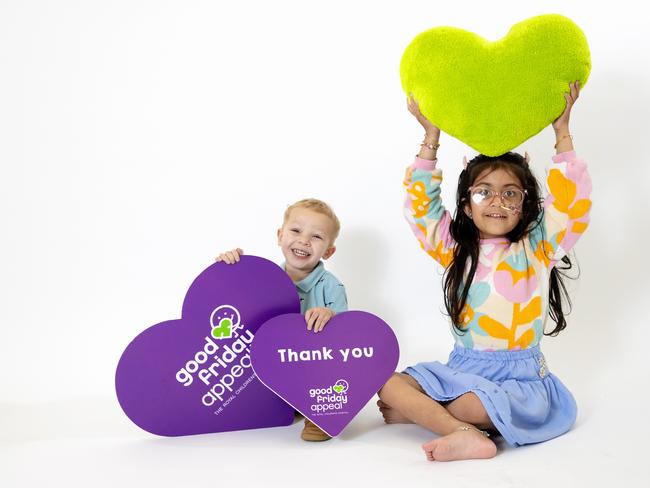
His older sister Anelita, now 5, did not meet her new brother for months because of lockdown restrictions and – on the difficult days – Bronte wondered if they ever would.
The sight of two-year-old Arlo, now “thriving” at home and so attached to Anelita he stands at the door waiting for her to return from school, is a testament to the miracles of the Royal Children’s Hospital.
“I love the moments when they’re getting in and playing with their toys and laughing because there were moments where I didn’t think that would ever happen,” she said.
“The two of them are inseparable, they’re best friends.
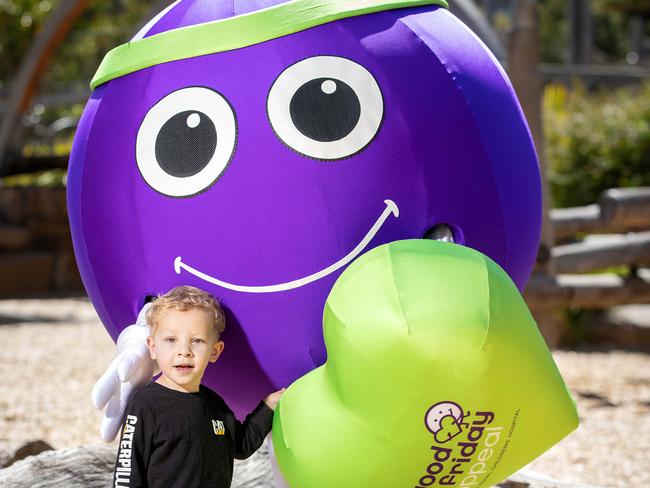
Any room he walks into, everyone is guaranteed to get a smile out of him.”
But it took a lot of strength — and six emergency open-heart surgeries in his first five-months of life — for her “happy, confident, funny kid” to get here.
Problems in Arlo’s heart were first detected at his mum’s 25 week scan — after Bronte warned the sonographer her daughter Anelita was born with some minor heart defects.
She said more complications were “picked up every week” and, prior to his birth, began to read up on other children who lived with his condition, Hypoplastic right heart syndrome.
She said, in simple terms, it means the right side of Arlo’s heart never formed, so it cannot keep “blue” (oxygenated) blood and “red” (un-oxygenated) blood separate.
“His blood is purple, it’s mixed,” she said. This leaves Arlo with dangerously low blood oxygen levels.
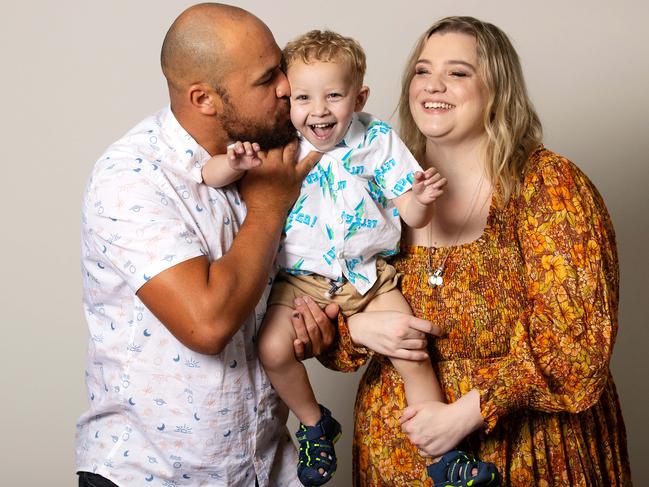
Bronte said, despite her research, she never found any children with her son’s exact combination – he has four other serious heart conditions – and fainted when told Arlo, just a few days old, was seriously unwell and needed to be admitted.
“In the womb his heart was thriving,” Bronte said.
“Once he took his first breath, he was no longer safe.
“All of a sudden, a new baby is basically almost dying.”
“He just went downhill and literally about four or five days later he would be having his first open heart surgery.”
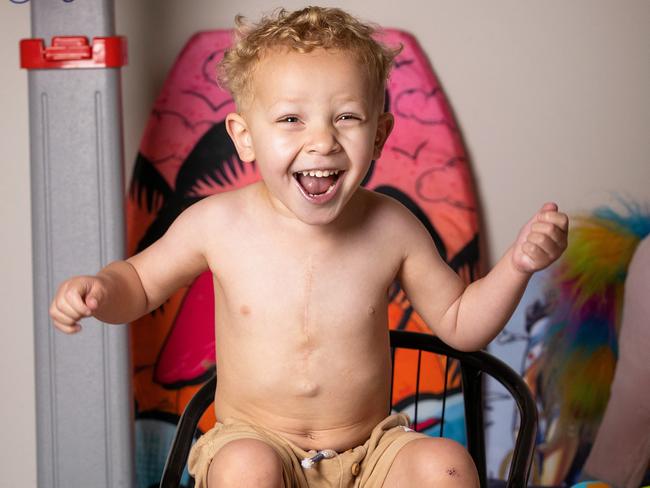
After he recovered from that first surgery, Bronte and Romi were overjoyed to take Arlo — now three-months-old — home to his sister for the first time.
But just three days later he was rushed back.
It was the start of a familiar pattern for the Santos, who learnt to go “one day at a time”.
They not only faced multiple surgeries, but nearly lost Arlo — too weak for vaccinations — when he contracted meningococcal bacterial meningitis, while a nasty bone infection triggered a six-month admission.
But last April his health started to improve and he finally got to spend more time at home than in a hospital bed.
He still has a long road ahead of him — including another major surgery — but Bronte has confidence in him, and the miracles of the Royal Children’s Hospital, from the cardiac surgeons who leapt into action and the therapists who could disguise treatment as ‘play’ to the ‘hospital at home’ team who finally allowed Arlo’s family to be together after Covid restrictions had separated them for so long.
“It literally takes a village,” she said.
“I have lost count of how many times he has come close and they have managed to save him,” she said.
Good Friday Appeal executive director Rebecca Cowan’s message:
“We are incredibly proud to call Arlo and Aru our 2023 Faces of the Good Friday Appeal. Hearing what they have been through in their young lives, along with the thousands of other patients who are being cared for by the hospital, is an example of why it is so important to get behind The Royal Children’s Hospital.
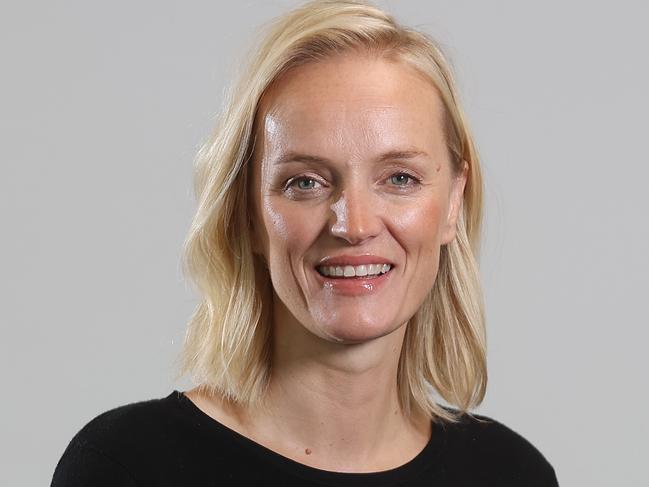
“The continued support and generous donations from the many towns and regions, alongside all of our generous fundraisers and partners, will ensure that even during the most challenging of times, children like Arlo and Aru are able to receive world-class care at The Royal Children’s Hospital.
“Every dollar raised from this year’s Good Friday Appeal is an investment towards The Royal Children’s Hospital’s big, bold and innovative projects, building on existing programs to improve children’s care and lessen the burden of chronic illness over the years to come.
“Knowing that it has been, and continues to be a very challenging time for many, the Good Friday Appeal sends its heartfelt thanks to all who continue to give what they can to create meaningful change for sick children and their families, enabling the RCH to provide leading healthcare and equal opportunities to our smallest children.”




